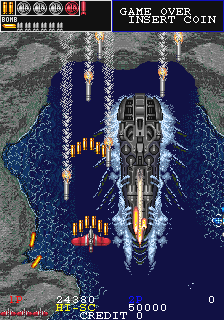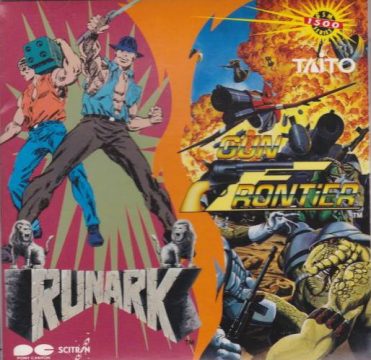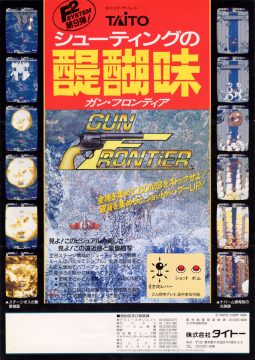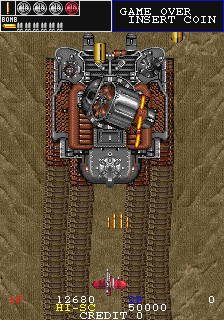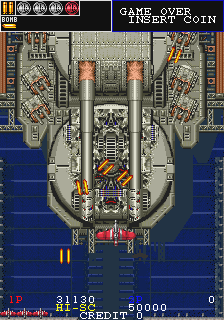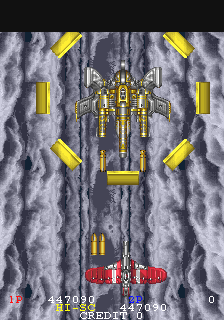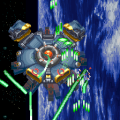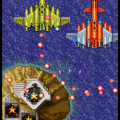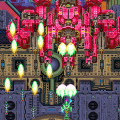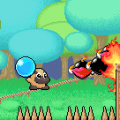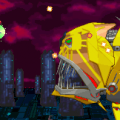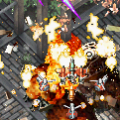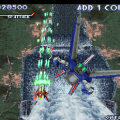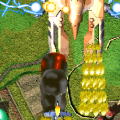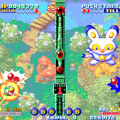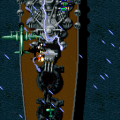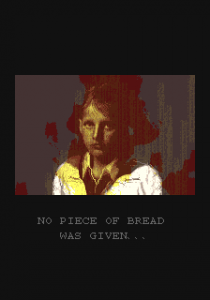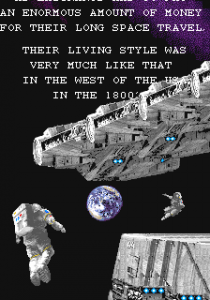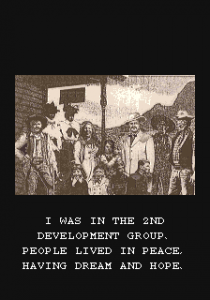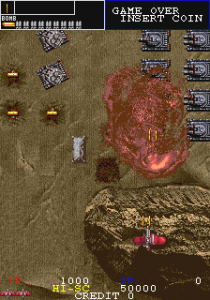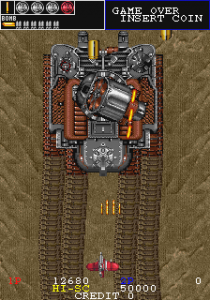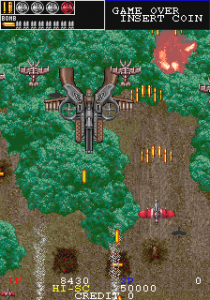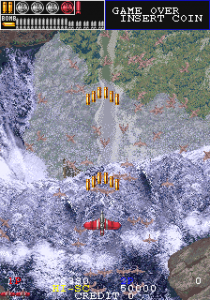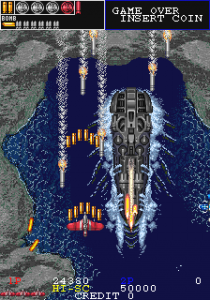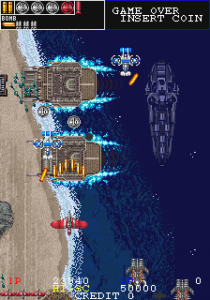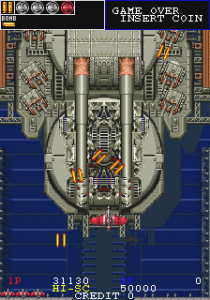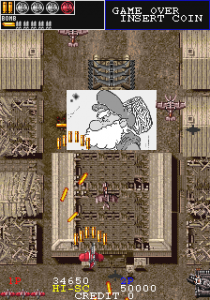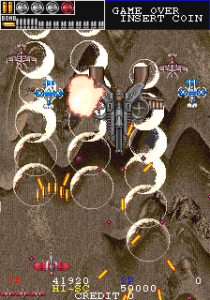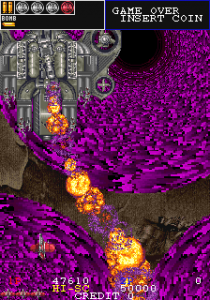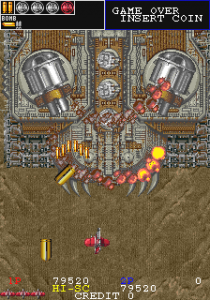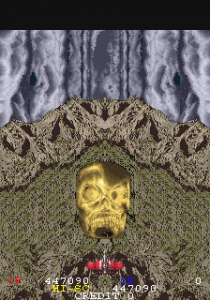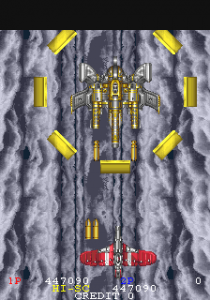Taito’s Gun Frontier is unique in that it’s one of the only shoot-em-ups to take place in a Wild West-type setting. Of course, it’s not ACTUALLY the Wild West – in order to justify the style, the story actually takes place in the 22nd century, as mankind has made its way into space and colonized a gold-rich planet named Gloria. Because of budgetary constraints due to the cost of reaching the planet, and technology being slow to rebuild, life on Gloria happens to resemble 1800s America. Of course, the Wild West is nothing without a gang of outlaws, and Gloria’s are known as the “Wild Lizards”. The major difference from actual history is there are flying aircraft, and most of them are shaped like guns.
Yes, the gimmick behind Gun Frontier‘s mechanical designs is that the vehicles are shaped like pistols and six-shooters. It’s one of those things that sounds a little ridiculous, and when looking at the official artwork, it kind of is. But in-game, when displayed with an overhead perspective with early 90s 2D graphics, it doesn’t look nearly as silly as it sounds.
The visuals have a brown, dust bowl feel, and while it’s not all that visually attractive, there are numerous details that liven up the atmosphere. In this universe, giant cannons have been replaced with gigantic six shooters, complete with the expulsion of used shells and reloading animations. Most of the larger battle tanks are carried via railroads and powered by steam. In one low level sweep over a town of wooden houses, you can destroy the cinema and see a few frames of a black and white movie behind shown (there are a couple different ones, which changes every time you play, one of which is based on the Taito game Don Doko Don). There’s a rather serene moment where you fly over a waterfalls and a flock of birds fly out right in front of you… which just happens to hide the boss lurking just below. The introduction uses the setting as an opportunity to stick in some digitized sepia-toned photographs of some authentic, disgruntled looking settlers, and which looks incredibly out of place next to the rest of the visuals.
In spite of its unique setting, most people remember Gun Frontier not for its atmosphere, but for serving as an inspiration for Shinobu Yagawa’s Battle Garegga, which was in turn followed up with nearly a half dozen other shooters with vaguely similar gameplay, including Battle Bakraid, Armed Police Batrider, Ibara, Pink Sweets and Muchi Muchi Pork. These are some of the most highly regarded shooters out there (though opinions differ, especially on the Ibara games), which in retrospect makes Gun Frontier a fairly significant title.
It’s easy to see which aspects Yagawa picked up for his own games, particularly Battle Garegga. The bomb system is identical. Ground-based enemies drop gold bars, and you need to collect 25 of bars to form a complete bomb (“Max Bomber”). However, if you have less than 25, you can spend them still unleash a powerful attack, but it’s not as powerful as a fully assembled bomb. These attacks can also be aimed in different directions. Each enemy plane explodes uniquely, whether falling to pieces or in a variety of flaming patterns. Most of the projectiles are oblong, much to the consternation of shooter fans more used to smaller, rounder bullets. And there is a rank system is place, depending on how quickly you fire your weapon.
However, anyone familiar with Yagawa’s games and then going back to play Gun Frontier will find it to be sedate in comparison. Your ship maneuvers slowly, enemy bullet waves aren’t particularly thick (though more numerous than many games from the era), and the stages just rather saunter by. That’s not to say that it’s easy, but it is certainly less demanding, and also a little less enthralling. Since the game was published in 1990, before the barrage of bullet hell shooters published by Cave and Raizing later in the decade, it’s much better viewed when placed next to contemporaries like Raiden.
It’s also more straightforward when it comes to scoring and weaponry. There’s not really a scoring system beyond “shoot everything”. And there’s only a single weapon, upgraded by grabbing silver coins dropped by certain enemies, which routinely appear flying together in waves. Given the slow speed of your ship, it can be difficult to hit more than one of them, so knowing when these enemies appear and how to prioritize their destruction is one of the key strategies in quickly powering up. Dying also sends you back to checkpoint and downgrades your weapon a bit While these respawn points are abundant, the screen doesn’t clear on each new life, so you’re confusingly tossed right into the fray, albeit with a few seconds of invulnerability. You can respawn immediately in boss battles, though you need to restart them if you run out of lives.
There are technically six stages, though the final level is really just for show, as your ship essentially becomes invincible as you plow through an armada and take out legions of huge sized enemies with just a few small hits. This is just a prelude to the most unusual final battle ever seen in a shoot-em-up. The penultimate foe surrounds himself with rotating shield, and you have six tries to time your shot correctly. Fail, and there’s no retrying, as you’re stuck with a lousy ending.
Most of the game was designed by Takatsuna Senba, who also was the producer and graphic designer. He also helmed Metal Black and Dino Rex, directed Darius II, and did graphics for Runark / Growl, SCI and Cadash. The soundtrack was composed by Hidetoshi Fukumori, and while he’s not part of Zuntata’s typical composers, it carries on the team’s reputation for quality, somewhat offbeat FM synth tunes. The second level theme, “Into the Sky”, sounds more like a new age inspirational song than a shoot-em-up, but damned if it’s catchy. Oddly, the only track that really sounds like Wild West music is used in the final stage.
While Gun Frontier wasn’t ported at the time of its initial release, it did make it to the Saturn several years later, in 1997, as part of Xing’s Arcade Gear series. It comes in a double CD case with an extra booklet courtesy of the magazine Gamest, which illustrates some high level strategy. The port itself is decent, and includes a tate mode, but it’s not arcade perfect – enemy placement is off, there are some minor graphical glitches, the sound effects are muffled, and since the music is played via redbook audio, there are some areas that are played in silence. One minor improvement: the bosses explode in gigantic flames that engulf the entire screen (a prelude to the awesome explosions found in Metal Black and Darius Gaiden), and in the arcade game, the animation is pretty choppy, but is buttery smooth in the Saturn version. On a whole, the Saturn version also easier, even on a high difficulty setting. Still, for the most part these are only issues for those really into the arcade game, and it’s a mostly excellent port.
It also appears on the Taito Legends 2 (US/EU for PS2 and Xbox) and Taito Memories Gekan (JP PS2) compilations, released in 2005/2006. It’s a close emulation of the arcade version, though it’s stuck in interlaced mode, and there is no tate option. By default, the image is stretched to the incorrect horizontal ratio, but this can be fixed to the proper size by changing the aspect ratio option in the main menu (the one on the title screen, not the options in the individual game.) It must be unlocked in the original Japanese release, either through meeting certain conditions or through a code, but in the re-release and the US/EU versions, it’s available normally.
A few notes about the name: Gun Frontier is also the name of an anime/manga by Leiji Matsumoto of Galaxy Express 999 fame, though it has nothing to do with this game, as the game was released a decade earlier. The English language version is known as Gun & Frontier, with a tiny ampersand stuck in the logo for reasons which are not entirely clear.
The 1991 game Metal Black introduces itself as “Project Gun Frontier 2”, but outside of sharing some of the same staff, the games are completely different – Metal Black is a side-scrolling shooter closer to Darius – and are only barely related. When in the planning stages of the game, Taito developed a plotline that tied in with Gun Frontier, mostly in that it featured the Wild Lizards gang as the primary antagonists. This was written only as a placeholder for internal use, since there were concerns that management would think the post-apocalyptic themes featured in Metal Black were too dark. However, this “dummy story” was published in various forms, including in magazine previews, and even made it into the manual of the Saturn of Metal Black. The official story of Metal Black, however, as told in a mini-comic and in the “The First” arrange CD, is completely different.
Additionally, some Japanese listings make mention of a Gun Frontier Extra Version. This is not publicly available in any form and may not have been released, nor is there any information about what was different in this version.
The American developed indie title Jamestown uses a similar aesthetic concept, with a Wild West frontier setting that actually takes place in outer space, though the similarity to Gun Frontier may be coincidental.
Links:
Wikipedia JP – Metal Black Source for the information about the connection to Metal Black.
